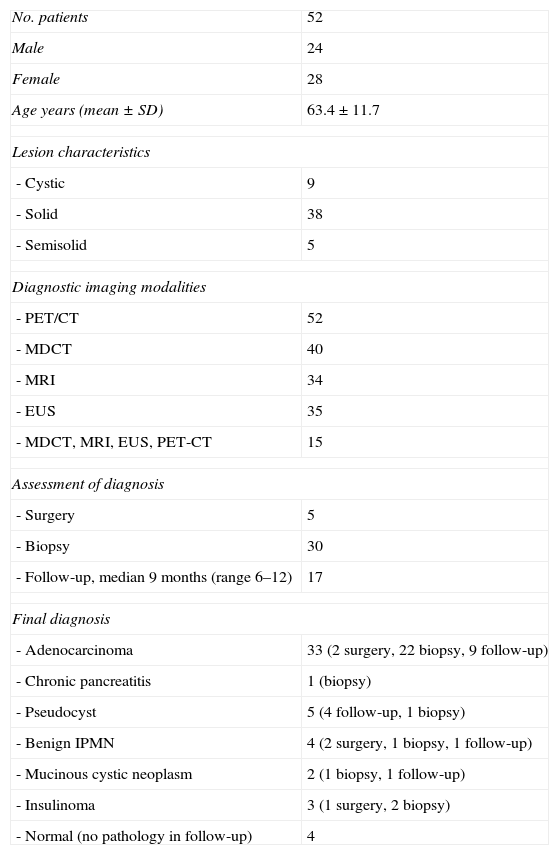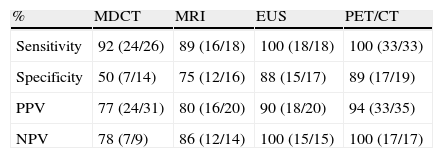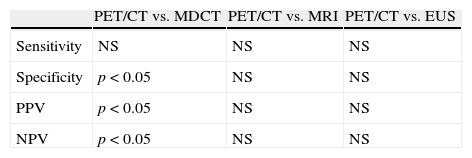We aimed to analyze the contribution of 18F-fluorodeoxyglucose positron emission tomography/computed tomography (FDG PET/CT) imaging to the diagnosis and management of pancreatic cancer compared with multidetector row computed tomography (MDCT), magnetic resonance imaging (MRI) and endoscopic ultrasonography (EUS).
Material and methodsWe retrospectively scanned the data of 52 patients who were referred for FDG PET/CT imaging for evaluation of pancreatic lesions greater than 10mm. The diagnostic performances of 4 imaging methods and the impact of PET/CT on the management of pancreatic cancer were defined.
ResultsPancreatic adenocarcinoma was diagnosed in 33 of 52 patients (63%), 15 patients had benign diseases of pancreas (29%), and 4 patients were normal (8%). Sensitivity and NPV of EUS and PET/CT were equal (100%) and higher than MDCT and MRI. Specificity, PPV and NPV of PET/CT were significantly higher than MDCT. However, sensitivities of two imaging methods were not significantly different. There was no significant difference between PET/CT and MRI and EUS for these values. When the cut-off value of SUVmax was 3.2, the most effective sensitivity and specificity values were obtained. PET/CT contributed to the management of pancreatic cancer in 30% of patients.
ConclusionFDG PET/CT is a valuable imaging method for the diagnosis and management of pancreatic cancer, especially when applied along with EUS as first line diagnostic tools.
El objetivo fue analizar la contribución de la PET/TC con 18F-FDG (FDG PET/TC) en el diagnóstico y tratamiento del cáncer de páncreas en comparación con la tomografía computarizada multidetector (TCMD), la resonancia magnética (RM) y la ecografía endoscópica (EUS).
Material y métodosSe revisaron retrospectivamente 52 pacientes que fueron remitidos para la evaluación de lesiones pancreáticas mayores de 10mm mediante FDG PET/TC. Se definieron los hallazgos diagnósticos de los 4 métodos de imagen y el impacto de la FDG PET/TC en el tratamiento del cáncer de páncreas.
ResultadosEn 33 de los 52 pacientes (63%) se diagnosticó un adenocarcinoma pancreático; 15 pacientes tenían enfermedades benignas del páncreas (29%) y 4 pacientes no mostraron enfermedad pancreática (8%). La sensibilidad y el valor predictivo negativo (VPN) del EUS y la FDG PET/TC fueron iguales (100%) y superior a la TCMD y a la RM. La especificidad, el valor predictivo positivo y el VPN de la FDG PET/TC fueron significativamente mayores que la TCMD; sin embargo, la sensibilidad de 2 métodos de imagen no fue significativamente diferente. No hubo diferencias significativas entre la FDG PET/TC, RM y EUS. Con un punto de corte de SUVmax igual a 3,2 se obtuvieron los valores más efectivos de sensibilidad y de especificidad. La FDG PET/TC contribuyó al manejo clínico del cáncer de páncreas en 30% de los pacientes.
ConclusiónLa FDG PET/TC es un método de imagen valioso para el diagnóstico y tratamiento del cáncer de páncreas, especialmente cuando se aplica junto con la EUS como primera línea de herramientas de diagnóstico.
Artículo
Si tiene problemas de acceso puede contactar con la Secretaría Técnica de la SEMNIM en el correo electrónico secretaria.tecnica@semnim.es o en el teléfono: + 34 619 594 780













